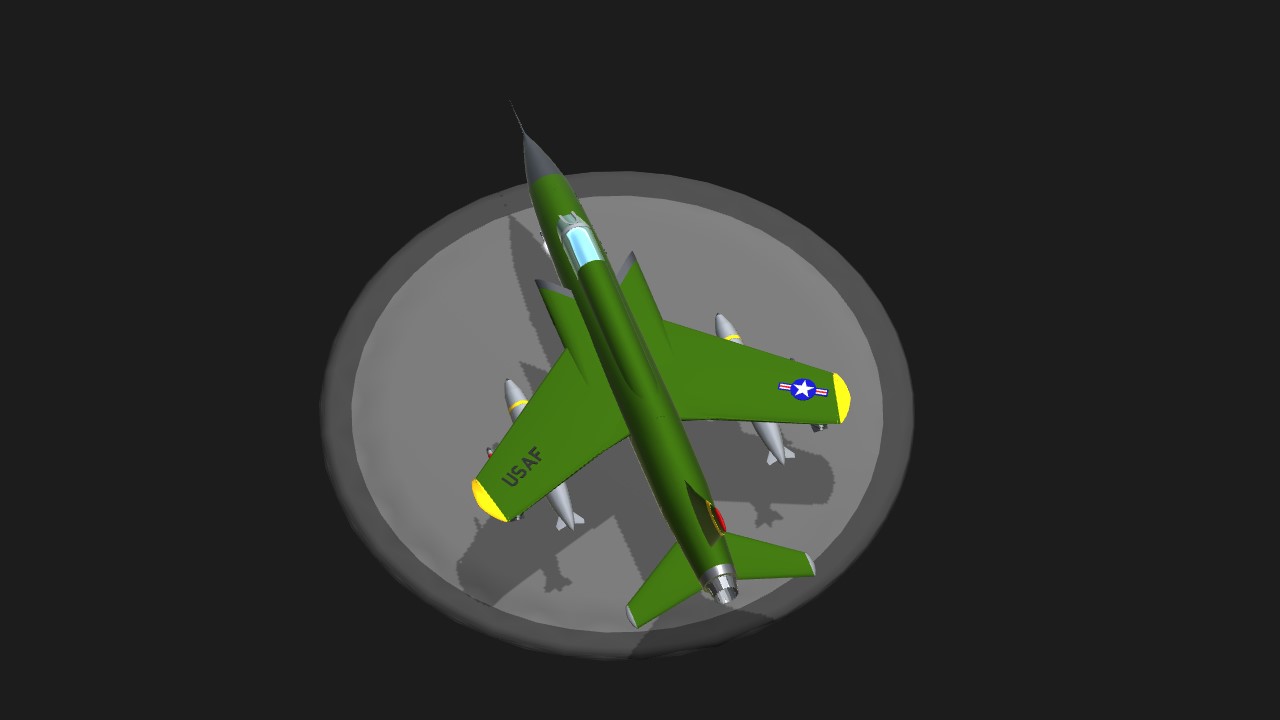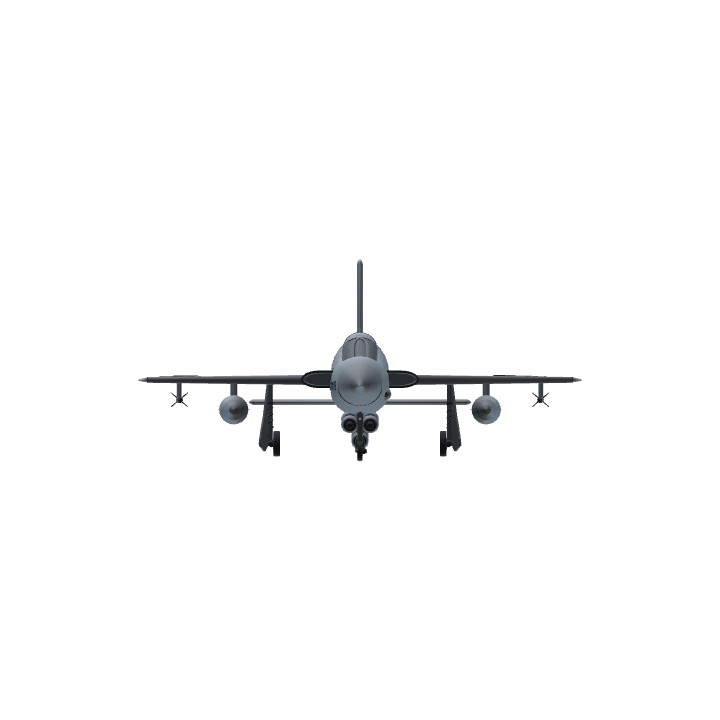Da ‘Thud’ , Lol get it? no?... ok...
.
.
.
.
.
.
.
.
.
.
Origins
Design phase
Republic Aviation started the Thunderchief as an internal project to replace the RF-84F Thunderflash, which first used the characteristic wing-root air intakes to make room for cameras in the nose section. The design team led by Alexander Kartveli examined some 108 configurations before settling on a large, single-engine AP-63FBX (Advanced Project 63 Fighter Bomber, Experimental), specifically AP-63-31.[4] The new aircraft was intended primarily for supersonic, low altitude penetration to deliver a single, internally carried nuclear bomb. The emphasis was placed on low-altitude speed and flight characteristics, range, and payload. The aircraft would be fitted with a large engine, and a relatively small wing with a high wing loading for a stable ride at low altitudes, and less drag at supersonic speeds.[5] Traditional fighter attributes such as maneuverability were a secondary consideration.[6]
Republic YF-105A, AF Ser. No. 54-0098, the first of two prototypes
Enthusiastic at first, the United States Air Force awarded Republic with a contract for 199 aircraft in September 1952.[7] However, by March 1953, the USAF had reduced the order to 37 fighter-bombers and nine tactical reconnaissance aircraft, citing the approaching end of the Korean War. By the time the F-105 mock-up had been completed in October 1953, the aircraft had grown so large that the Allison J71 turbojet intended for it was abandoned in favor of the more powerful Pratt & Whitney J75. Anticipating a protracted development of the engine, it was expected that the first aircraft would use the smaller Pratt & Whitney J57. Near the end of 1953, the entire program was canceled by the USAF due to a number of delays and uncertainties regarding the aircraft. However, on 28 June 1954, the USAF officially ordered 15 F-105s (two YF-105As, four YF-105Bs, six F-105Bs, and three RF-105Bs) under the Weapon System designation WS-306A.[4][8][9]
The YF-105A prototype first flew on 22 October 1955, with the second YF-105A following on 28 January 1956.[8] In spite of being powered by a less potent J57-P-25 engine with 15,000 pounds-force (67 kN) of afterburning thrust, the first prototype attained the speed of Mach 1.2 on its maiden flight. (The J75 was expected to generate 24,500 lbf (109 kN) with afterburner.)[10] Both aircraft featured conventional wing root air intakes and slab-sided fuselages typical of the early jets; Republic viewed the prototypes as not being representative of the true capability of the aircraft due to numerous changes prior to production.[11] Insufficient power and aerodynamic problems with transonic drag, as well as Convair's experience with their F-102, led to a redesign of the fuselage to conform to the area rule, giving it a characteristic "wasp waist".[12] In combination with the distinctive forward-swept variable-geometry air intakes which regulated airflow to the engine at supersonic speeds and the J75 engine, this redesign enabled the F-105B to attain Mach 2.15.[13][14]
Into production
A USAF F-105F trainer and a F-105D with Mount Fuji in the background
In March 1956, the USAF placed a further order for 65 F-105Bs and 17 RF-105Bs.[15] In order to conduct the nuclear mission, an MA-8 fire control system, AN/APG-31 ranging radar, and K-19 gunsight to allow for toss bombing were integrated.[16] The first pre-production YF-105B flew on 26 May 1956.[15] Five of the F-105C trainer variant were added to the procurement plan in June 1956, before being canceled in 1957. The RF-105 reconnaissance variant was canceled in July 1956.[17] The first production F-105B was accepted by the Air Force on 27 May 1957.[18] In June 1957, Republic Aviation requested that the F-105 be named Thunderchief, continuing the sequence of the company's Thunder-named aircraft: P-47 Thunderbolt, F-84 Thunderjet, and F-84F Thunderstreak. The USAF made the name official a month later.[17]
To fulfill the Air Force requirement for all-weather attack, Republic proposed the F-105D variant in 1957. This version featured an enlarged nose and radome housing the AN/ASG-19 Thunderstick bombing/navigation system. The AN/ASG-19 was designed around the Autonetics R-14A radar, which operated in both air-to-air and air-to-ground modes, and the AN/APN-131 Doppler navigation radar. In the cockpit, the F-105D featured vertical-tape instrument displays for adverse weather operation. The ability to carry the TX-43 nuclear weapon was also added. The RF-105 reconnaissance development was also restarted, now based on the F-105D. The first D-model took its maiden flight on 9 June 1959.[19] Plans to build over 1,500 F-105Ds were cut short when Secretary of Defense Robert McNamara decided to equip no more than seven combat wings with the type. In November 1961, production was cut in favor of the Air Force adopting the Navy's F-4 Phantom II,[20] and in the longer term, the General Dynamics F-111 Aardvark of the TFX program.[21]
The final 143 Thunderchiefs built were of the two-seat F-105F trainer variant. Based on the F-105D, this model was 31 inches (79 cm) longer to provide room for the rear cockpit; otherwise, the aircraft had similar flight performance to the preceding F-105D.[22][23] A total of 833 F-105s were completed before production ended in 1964.[24] The F-105 had been designed for a short nuclear campaign, leading to shortcomings that became evident in a lengthy conventional war, such as a poor hydraulics layout and fuel tanks that were not self-sealing.[25] Subsequent upgrades improved the reliability and weapons capacity of the existing F-105Ds. In response to the surface-to-air missile (SAM) threat experienced in the skies above Vietnam, dozens of F-105Fs were converted into anti-radar "Wild Weasel" aircraft, culminating with the F-105G.
Source : Wikipedia
.
.
.
.
.
.
.
.
.
.
CONTROLS :
-AG1 + VTOL Up : Retract Landing Gear
-AG2 : Activate M-61 Fulcan
-AG3 : Jettison (Drop) External Fuel Tank
-AG4 : Activate 2x AIM-9 Sidewinder
-AG5 : Activate 6x 750lb Bomb
-AG6 + Brake : Airbrake
.
.
.
.
.
.
.
.
.
.
.
.
.
.
.
.
.
If you like My Creation pls consider Upvoting, Hehe... 😸
.
.
.
.
.
THX!!!....
Specifications
Spotlights
- Trainzo 3.9 years ago
General Characteristics
- Successors 1 airplane(s) +7 bonus
- Created On iOS
- Wingspan 37.4ft (11.4m)
- Length 60.7ft (18.5m)
- Height 17.0ft (5.2m)
- Empty Weight 14,108lbs (6,399kg)
- Loaded Weight 20,222lbs (9,172kg)
Performance
- Power/Weight Ratio 1.666
- Wing Loading 79.1lbs/ft2 (386.2kg/m2)
- Wing Area 255.6ft2 (23.8m2)
- Drag Points 5537
Parts
- Number of Parts 243
- Control Surfaces 5
- Performance Cost 973







@ACEPILOT109 @BlackThuNDR @DameTheNewbie Thuudddd
Requested Tags :
@Ergi
@ExiledKristen
@RandomUser09
Requested Tags :
@Noname918181
@DaddyUnt
@EnzoDiazOfficial
Requested Tags :
@WiiMini
@TheMegaMauster
@SHDQ136
whoops, my bad xD guess i forgot @Inuyasha8215
thx! @Trainzo
Nice Thunderchief but why no petal airbrakes?
Very nice build , great plane
@MIAW26PERSIAN B.
thoonder @TirpitzWantsPlanes
e @TheMegaMauster
@WiiMini |if only you can put this in SPSC featured bui- wait ... oh nothing xD just daydreaming
@MIAW26PERSIAN
if only you can put this in SPSC featured bui- wait ... oh nothing xD just daydreaming @TheMegaMauster
xD thanks bud.. for now guess ill stick eith my ancient iphone lol,
anyway i hope you like my f-105!... ;) @TheMegaMauster
Give this man a 2021 iPad Pro, or even a RTX 3090 setup. He just needs a larger screen to build better planes.
O. @SturmGeschutzIV
@MIAW26PERSIAN H.
Jundroo :
SP < SR2
@SHDQ136
Da Thunder
E. @SturmGeschutzIV
@MIAW26PERSIAN on SR2, the inlet look more... realistic
Yes.
indeed lol @SHDQ136
This game has a weird looking inlet
fastest updoot from the unknown shores of the south-eastern realm